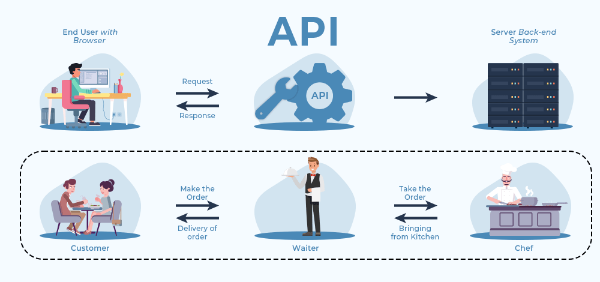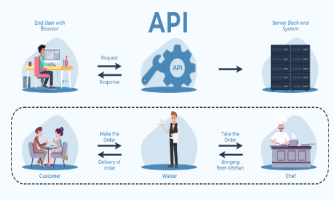An API is a set of rules, protocols, and tools that allows different software applications to communicate with each other. It defines the methods and data structures that you can use to interact with an external system or service, without needing to know how that system is implemented internally.
Think of an API as a waiter in a restaurant:
-
You (the customer) are the application.
-
The kitchen is another application or service (like a database, server, or external platform).
-
The menu is the API documentation, listing what you can order.
-
The waiter (the API) takes your request, communicates it to the kitchen, and then brings the food (the data or response) back to you.
You don't need to know how the kitchen works; you just need to know how to order from the menu.
How do APIs Work?
APIs work primarily using HTTP requests (the same protocol that powers the web). The most common types of HTTP requests are:
-
GET: Retrieve data from a server (e.g., get a user's profile).
-
POST: Send data to a server to create a new resource (e.g., create a new user).
-
PUT/PATCH: Update existing data on a server (e.g., change a user's email).
-
DELETE: Remove data from a server (e.g., delete a post).
A typical API interaction involves these steps:
-
A client application sends a request to a specific URL (API endpoint).
-
The request often includes necessary information like:
-
Authentication (e.g., an API key) to prove it has permission.
-
Parameters to specify what data it wants.
-
A body (for POST/PUT requests) containing the data to be sent.
-
-
The server processes the request.
-
The server sends back a response, which includes:
-
A status code (e.g.,
200 OKfor success,404 Not Foundfor a missing resource,401 Unauthorizedfor bad authentication). -
The requested data, usually in a format like JSON or XML.
-
Common Types of APIs
-
REST (Representational State Transfer): The most popular architectural style for web APIs. REST APIs are known for being:
-
Stateless: Each request contains all the information needed to process it.
-
Cacheable: Responses can be stored to improve performance.
-
Use standard HTTP methods (GET, POST, etc.).
-
-
SOAP (Simple Object Access Protocol): A more formal and structured protocol that uses XML. It is older and often used in enterprise environments.
-
GraphQL: A newer query language that allows clients to request exactly the data they need, nothing more and nothing less, in a single request.
Real-World Examples of APIs
-
Weather Service: A weather app on your phone uses an API to get the latest forecast data from a remote server.
-
Payment Gateway: An e-commerce website uses the Stripe or PayPal API to process credit card payments securely without handling sensitive data directly.
-
Social Media Login: A website that lets you "Log in with Facebook/Google" uses their APIs to authenticate your identity.
-
Travel Booking Sites: Sites like Kayak or Booking.com use APIs from airlines and hotels to aggregate prices and availability.
Key Terminology
-
Endpoint: The specific URL where an API can be accessed.
-
JSON (JavaScript Object Notation): A lightweight data format that is easy for humans to read and for machines to parse. It's the most common format for API data.
{ "userId": 1, "name": "John Doe", "email": "This email address is being protected from spambots. You need JavaScript enabled to view it. " } -
API Key: A unique identifier used to authenticate a project or application calling an API.
-
Documentation: Instructions provided by the API creator that explain how to use the API effectively.
-
Rate Limiting: A restriction on how many API requests a client can make in a given time period to prevent abuse.
Why are APIs Important?
-
Efficiency: Developers don't have to build everything from scratch. They can leverage existing services.
-
Integration: They allow different systems and platforms to work together seamlessly.
-
Innovation: Companies can expose their data and functionality, allowing others to create new and innovative applications.
-
Security: APIs provide a controlled and secure way to access data and functionality without exposing the internal database.











Comments powered by CComment